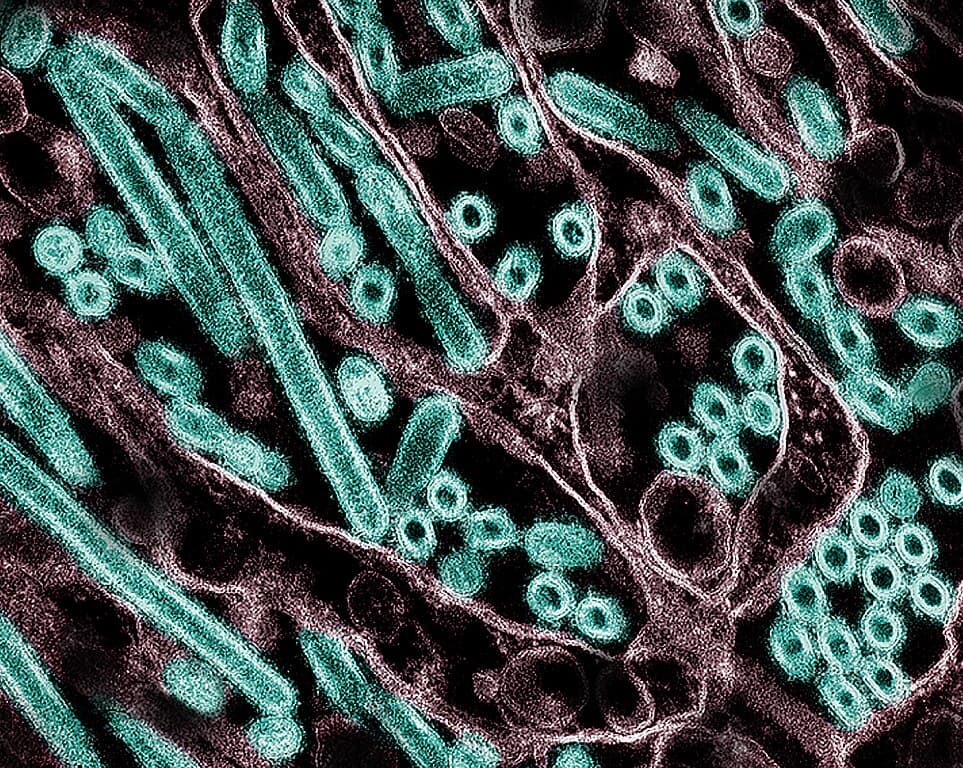Global virologists call for urgent action on H5N1 avian influenza threat
Leading experts from the Global Virus Network have published a comprehensive analysis highlighting the increasing risk posed by H5N1 as the virus spreads through US cattle herds and causes human infections.

H5N1 virus
The Global Virus Network (GVN), representing virologists from more than 80 Centres of Excellence across 40+ countries, has issued an urgent call to action regarding the escalating threat of H5N1 avian influenza. In a paper published in The Lancet Regional Health – Americas on 28 April 2025, the network outlines a multi-faceted approach to address what they describe as a significant and growing threat to public health.
Current state of H5N1 spread
The highly pathogenic avian influenza virus is now circulating in all 50 US states and Canada, affecting nearly 1,000 dairy cow herds and resulting in more than 70 human cases, including the first confirmed human death in the United States. Since 2022, the outbreak has led to the loss or culling of more than 168 million poultry in the US alone.
“Understanding the current landscape of H5N1 infections is critical for effective prevention and response,” said Professor Sten H. Vermund, Chief Medical Officer of the GVN and Dean of the USF Health College of Public Health. “The virus’ ability to infect both animals and humans, combined with recent genetic changes, underscores the importance of proactive surveillance and rapid response measures.”
Whilst human-to-human transmission has not been documented, experts emphasise that the risk remains significant. The virus could potentially undergo mutations or reassortments – combining with other influenza viruses – that might increase transmissibility between humans, a scenario that could trigger a global pandemic.
Surveillance and data sharing critical to monitoring evolution
A central recommendation from the GVN is the enhancement of surveillance systems to track the virus’s evolution. This includes comprehensive monitoring of infected animals, testing of milk and wastewater, and screening of individuals working with infected animals.
Professor Marion Koopmans, Center of Excellence Director at the GVN and head of the department of viroscience at Erasmus Medical Center, Netherlands, emphasised the importance of genomic surveillance: “Genomic surveillance is pivotal in tracking viral evolution and informing response strategies. Continued investment in surveillance at the human-animal interface, and immediate sharing of unusual field observations and sequence data is essential for researchers worldwide to monitor virus dynamics effectively.”
The GVN report highlights the current gaps in monitoring, noting that existing surveillance efforts are insufficient to guide effective prevention strategies or assess the virus’s spread and risks to public health.
“A robust nationwide monitoring system is essential to quickly detect and quarantine affected animals and implement preventive measures to curb further spread and human infections,” said Dr Elyse Stachler, member of the GVN and a research scientist at the Broad Institute of MIT and Harvard.
Ten-point plan for pandemic preparedness
Drawing on lessons from the SARS-CoV-2 pandemic and previous outbreaks, the GVN has outlined a comprehensive ten-point plan for pandemic preparedness:
- Enhanced surveillance through continuous monitoring of animals and at-risk humans
- Faster genomic data sharing to track virus evolution and transmission
- Improved farm biosecurity using personal protective equipment and strict cleaning protocols
- Preparedness plans for the roll-out of self-administered diagnostic tests
- Strengthened public health infrastructure, particularly in high-risk regions
- Investment in predicting phenotypes from genetic data
- Development and rapid deployment of vaccines for humans and animals
- Preparedness plan for the roll-out of vaccines and therapeutics
- Protocols to allow for rapid clinical studies of emerging virus strains
- International collaboration to coordinate global response efforts
Professor Peter Palese, Center of Excellence Director at the GVN and Professor at the Icahn School of Medicine at Mount Sinai, stated: “Initiatives should focus on enhancing biosecurity measures in agricultural settings and educating the public about safe handling of poultry products and potential risks associated with contact with infected animals.”
Focus on cattle transmission and community buy-in
With H5N1 increasingly circulating in mammals, the GVN is calling for urgent efforts to understand and interrupt transmission in cattle. Professor Ab Osterhaus, Center of Excellence Director at the GVN and founding director of the Center of Infection Medicine and Zoonosis Research at the University of Veterinary Medicine Hannover, Germany, explained: “Given the growing circulation of H5N1 among mammals, the GVN calls for urgent efforts to understand and interrupt transmission in cattle through herd management and potential vaccination. Strengthening surveillance at animal-human interfaces is crucial, as current monitoring efforts are insufficient to guide effective prevention strategies.”
The network emphasises that community engagement is essential for successful implementation of any intervention strategies, including vaccination programmes if they become necessary.
“We are advocating for community-driven strategies to ensure the successful implementation of vaccines, if necessary,” said Professor Christian Bréchot, Vice Chair of the Board of Directors and President Emeritus of the GVN. “The situation with H5N1 demands heightened vigilance and collaboration across public health sectors. Early detection and robust surveillance are critical to prevent further spread.”
The publication in The Lancet Regional Health – Americas serves as both an analysis of the current situation and a roadmap for coordinated international action to mitigate the threat posed by H5N1 avian influenza.
Reference:
Global Virus Network. (2025). A comprehensive analysis and call-to-action on the North American avian influenza virus (H5N1) outbreak. The Lancet Regional Health – Americas. https://www.sciencedirect.com/science/article/pii/S2667-193X(25)00110-3

